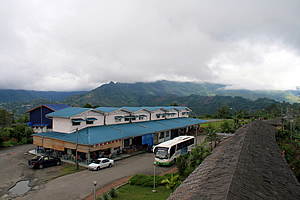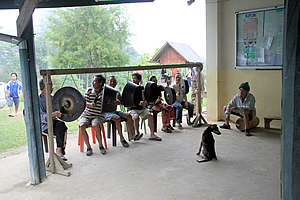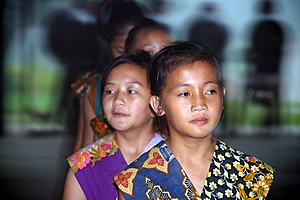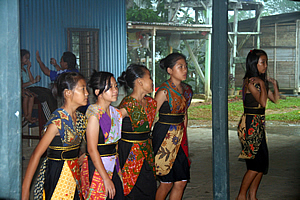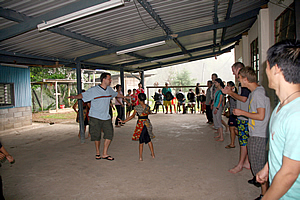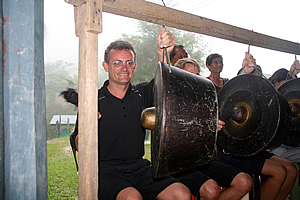--- Archive files ---
Home > Treks > Kinabalu > Day 1 > 1.2 |
Warm Welcome Enveloped in Cold Cloud
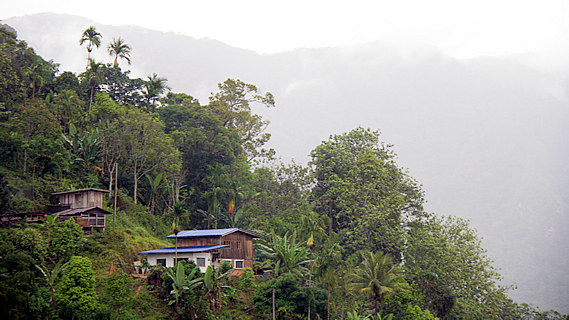
IT HAD been a long drive up the mountain from Kota Kinabalu. the winding road had ascended fifteen hundred metres before reaching the top of the ridge. The driver stopped the van at a village on top of the ridge, containing mostly cafes. There was a viewing platform across the road, so we climbed on it. There was supposed to be a spectacular view ofthe mountain from here, but the thick cloud hovering overhead denied us the view.
View from the lookout |
Once stretched and relaxed, we returned down the stairs from the viewing platform back to the van ready to start the next stage of our journey. We only drove another hundred metres up the road before pulling over to where several four wheel drive vehicles were parked. There were several people there. Their skin was the same colour as most other Malays, though perhaps a little paler, but the shapes of their faces appeared different. Rather than the flat rounded faces and small noses of the other Malays I had met so far on this trip, these people had faces that protruded out more. They seemed to be a slightly different race. They helped us unload our backpacks from the van and put them in the back of a four wheel drive pickup truck.
|
There were two men who sat in the front. The driver was Lianty. His assistant Muda would have still been a teenager, with hair a little too long and perhaps a little flabby obviously not having joined the workforce as a porter yet. Another man was in another truck taking the rest of our group.
We climbed into the back seats of the four-wheel drive vehicles with the locals and started heading down a gravel road that went off the main road. The contrast in road conditions was startling. The highway we had come off was in excellent condition and easy for any vehicle to drive along with ease. The gravel road we were now following was very narrow, winding and plunging steeply downhill.
|
Lianty negotiated the vehicles down a precarious spur and continued steeply dropping downhill until we eventually reached the ford over a small river. We crossed over the river in convoy before ascending steeply up the gravel road. There was a bridge under construction nearby, but until that is finished the only access was across the ford. The road turned twice in precariously slippery hairpin bends before we suddenly saw some houses along the side of the road. Then I realised this was the village I had seen from the lookout. The road continued to ascend very steeply through the village, passing several very small houses. We reached a very small saddle where the road continued climbing precariously uphill, but we stopped at the saddle parking right in the middle of the steep road. We had apparently arrived.
Echoes of metallic percussive music sounded as we walked up the short rise from the road towards a building on top of a small plateau. Cloud quickly closed in around us. It was a lot cooler up here than it had been in Kota Kinabalu, but not cold enough to chill us.
Welcome by the villagers |
We approached the building, where there was an open communal area on a concrete slab with a corrugated iron roof overhead. Five men and one woman from the village were playing black metal gong-like instruments hanging from a beam elevated about one point four metres above the ground. They played in a percussive syncopation, each musician playing a simple beat. There was a mangy dog wandering around on the floor in front of the musicians who continued to welcome us with the music as we watched.
The people were all very short, but quite stocky and well-built with firm definition on their serious faces only encountered by people who live in mountainous terrain exposed to the harsh sun and storms only found in alpine areas. It was interesting seeing an Asian version of mountain people as I was all too familiar with the deeply weathered faces of the New Zealand wilderness folk who lived in the remote mountainous regions of the South Island.
There were about five other people sitting around. They were all younger than the musicians. Perhaps they were the apprentices? On the far side of the enclosed area were two rows of seats set up for us to sit in, but we needed to unpack and settle down first.
Lianty led us through the open roofed area to a large grassy common levelled from the top of the hill. The grassy common was surrounded by small wooden buildings. He led us to the nearest building, a two storey building where we climbed the precariously uncomfortable staircase up to the top level.
|
Once at the top of the staircase, we entered the building into a small common area with two bunkrooms going off on either side. I entered one of the bunkrooms with Richard, Casper and Tobias, while the others all occupied the other bunkrooms. I took a bottom bunk, and quickly unpacked before getting my little video camera and joining the others back in the open area where the musicians had been playing.
The swirling cloud was very thick now obscuring the surrounding trees into ghostly apparitions. It was quite dark inside the covered area. The chief of the village arrived with a large group. He gestured us to sit on some plastic chairs. He introduced himself as Sapinggi Ladsou. He was in his mid-fifties but looked far younger. The only thing giving away his age were the heavily weathered lines on his brazen face accentuated by his huge beaming smile. As we would later find out, the weathering of his face was the result of the countless ascents he had done to the summit of the mountain. It still wasn’t sinking in though. I was about a third of the way up the steep slopes of the mountain, yet what lay above was still eluding us. Sapinggi was well dressed for a tribal chief I thought, wearing an ironed grey short sleeved shirt untucked over his black trousers. He warmly welcomed us to his village, and said each time a group arrives, one of the families entertains them. One of the large families was going to entertain us today.
He went on to talk about the people who lived here. He was the chief of one of the indigenous Orang Dusun tribes of Sabah. The thirty or so groups of the Dusun make up about thirty percent of the population. Each group has its own dialect, and each has its own unique customs.
Dancers |
Most of the Dusun tribes live in the hills and upland valleys. They are well renowned for their peacefulness, hospitality and frugality, being adverse to any kind of violence. On the other hand, they are very hard workers and have a passion for their music, dancing and drinking. Their dance and music is attractive and gentle, yet demonstrating their passion for life.
Sapinggi mentioned that the tribe here were the keepers and guardians of the mountain, and they had been blessed with having been donated the section of the village in which we were staying. The donation had come from the Catholic Church, and obviously with it came a change in their values from animism to Christianity – perhaps buying out their traditional ways. Although Christianity was very important to them, they somehow managed to strike a good balance between their new faith and their traditional ways.
Dancers |
The musicians started beating on their drums and gongs again, and the children of one of the families started performing a dance. There were five young girls in beautifully coloured woven cloths wrapping loosely around their bodies in a figure of eight over black dresses tunics and five boys dressed in black short sleeved shirts and baggy long pants looking like ninjas. The dance had very simple, but very definite and effective moves.
Heavy rain was now falling on the corrugated iron roofing above our heads to the extent that it became hard to hear the music, but still the dance went on under the cover of the roof above us. The cocoon of cloud felt very thick, cold and damp. It was getting substantially dark even though it was still mid-afternoon and the sun would still be high above us.
Dancers |
Soon the children stopped dancing, and some of the adults of the village suddenly appeared from nowhere. We were led into a line on one side of the courtyard and the villagers lined up the other side. We danced their routine, although our attempt was nowhere near as effective. I’ve always found dancing to be very awkward at the best of times. We did quickly pick up the pattern where one person from either side would be dancing the slow dance whilst everyone on the sides was clapping slowly to the syncopated rhythm.
Once the dancing was finished, the musicians offered us their drumsticks to play their large metal drums. Several of us responded and took our seats at the gongs. Each man demonstrated to us the rhythm we had to play. Thankfully I have been playing piano for nearly thirty years, so from that I did have some concept of keeping a rhythm. The syncopation sequence I was showed would have been quite complex to a non-musician, but naturally I picked it up very quickly. Hitting the same place I think I was hitting a low F natural – it’s a little hard to tell with percussion instruments.
Trying out the bass gong |
We all played along according to what we had been taught. A couple of us had been allocated complex rhythms, whilst others had a very simple regular beat. Amazingly we were pretty tight and it sounded amazing. Richard was impressed. He later mentioned most groups struggle with playing this music, and I don’t think anyone else apart from myself and Richard was musicians. Richard plays a lot of guitar so he said in the van on the way up earlier this afternoon.
After several photos were taken of us playing the small gongs, we left the instruments and took part in another dance with some of the adults of the village who had suddenly appeared from nowhere – they seemed pretty good at that.
|
The rain miraculously stopped falling just as the dancing finished. We were therefore able to return to our hut relatively dry. I took a few pictures of the thick mist before the cloud quickly lifted. There was a large grassy courtyard behind us, and buildings going around the courtyard. We didn’t know what most of the buildings were, apart from two blocks of rather crude toilets and showers.
We went out onto the courtyard to play with the children and admire the view. They were looking at a picture someone else had taken of them. We could see all the way to the river at the bottom of the valley now, and some of the lower slopes of the mountain were beginning to reveal itself as the cloud continued to lift.
By now the rain had completely stopped falling. We walked out to the front of the buildings to look up at the rest of the village. Sapinggi told us the mountain was in the direction we were looking, but the clouds needed to lift at least another two thousand metres before we would be able to see it.
Maybe the mountain elusive will show itself tomorrow.
<< Previous | Next >> |
|
||
About this Page
|
||
|
|
|
Where is Walkabout Jeff? |
|
|
|
|
What is happening in Walkabout Jeff's hometown?
|
|
|
|
|
Who is Walkabout Jeff?Any normal person's idea of going out involves going to the local pub for a drink with a few mates. Walkabout Jeff isn't normal.
|
|
|
|
|
